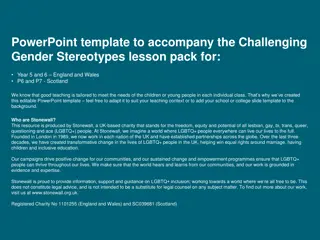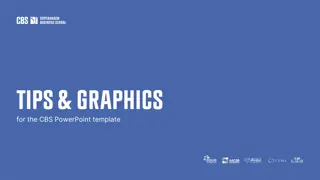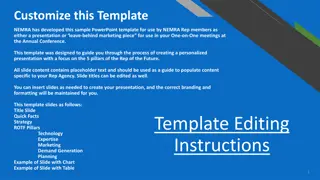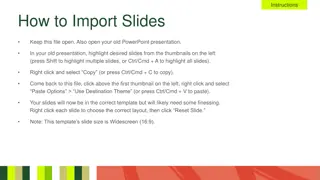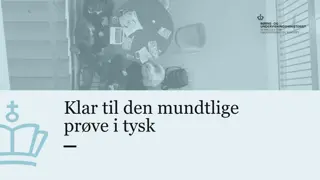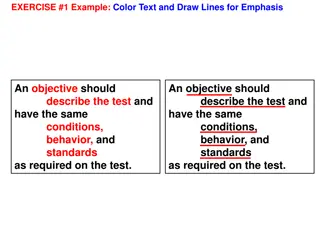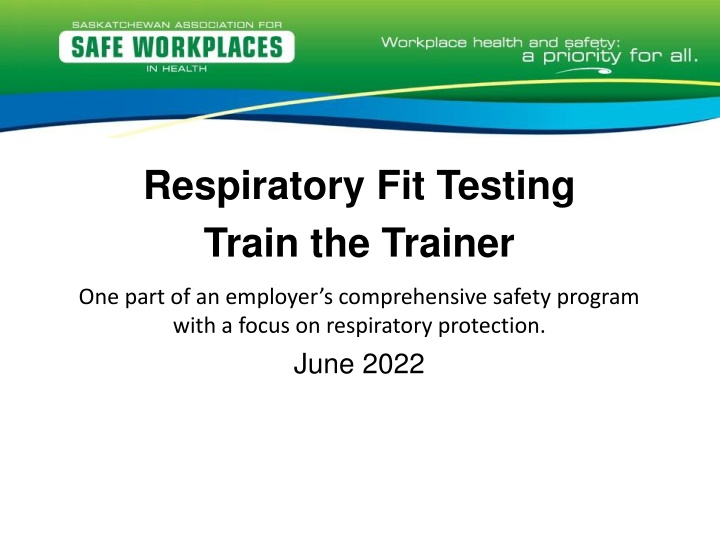
Respiratory Fit Testing Train the Trainer Program Overview
Explore the comprehensive safety program focusing on respiratory protection, including fit testing techniques, roles and responsibilities, legislation, and more. Get insights on SASWH-approved fit testers, re-approval requirements, and the importance of training in occupational health and safety. Enhance your knowledge and skills in ensuring a safe work environment through proper respiratory protection measures.
Uploaded on | 1 Views
Download Presentation

Please find below an Image/Link to download the presentation.
The content on the website is provided AS IS for your information and personal use only. It may not be sold, licensed, or shared on other websites without obtaining consent from the author. If you encounter any issues during the download, it is possible that the publisher has removed the file from their server.
You are allowed to download the files provided on this website for personal or commercial use, subject to the condition that they are used lawfully. All files are the property of their respective owners.
The content on the website is provided AS IS for your information and personal use only. It may not be sold, licensed, or shared on other websites without obtaining consent from the author.
E N D
Presentation Transcript
Respiratory Fit Testing Train the Trainer One part of an employer s comprehensive safety program with a focus on respiratory protection. June 2022
HousekeepingDetails http://www.diyderby.co.uk/ekmps/shops/bartlam/images/emergency-exit-sign-300-x-200-code-1516-1024-p.jpg
Welcome & Introduction Welcome to Respiratory Fit Testing TTT Successful completion of this program includes: active involvement in discussion return demonstration Evaluation pre session Please follow along in the Fit Tester Protocols and Resources Binder
Introductions Your name Where you work Previous experience with fit testing
What You Will Learn Understanding Saskatchewan s Occupational Health and Safety legislation and CSA standards pertaining to Fit testing Overview of roles and responsibilities in a respiratory protection program Hazard assessment Selection of appropriate respirator Respirator fit testing (qualitative and quantitative) Orientation (self directed and facilitated) Health Surveillance Training Program evaluation Recordkeeping Cleaning, inspection, maintenance and storage of respirators Principles of Qualitative Fit Testing Principles of Quantitative Fit Testing Page 1
SASWH Approved Fit Testers Fit test trainers approved by SASWH have access to resources such as a PowerPoint for orientation and forms referenced in this material. Visit www.saswh.ca and login/register with the following username and password (case sensitive) Username: RPP1 Password: RPP2 Page 1
Re-Approval Fit testers require re-approval every 2 years by attending SASWH s fit tester re-evaluation session. A fit tester will be eligible for re-approval so long as they have fit tested/taught a minimum of 5 workers in the previous 2 years. Page 1
Legislation Definition of train Means to give information and explanation to a worker with respect to a particular subject matter and require a practical demonstration that the worker has acquired the knowledge or skill related to the subject-matter Page 2
Supplies for Fit Testing Orientation (either the presentation or worker s can read the document) Respirator user screening form Respirator user tracking form NIOSH approved respirators (elastomeric and/or disposable) Mirror Equipment/Supplies for the method of fit testing you are conducting (qualitative, or quantitative) Safety data sheet for the sensitivity solution, and fit test solution (qualitative) Safety data sheet for the alcohol solution (quantitative) Water for participants of qualitative fit testing Stickers/Wallet cards Additional PPE that may be required based on the current situation Page 2
Risk Assessments Self Risk Assessment Consider if the fit tester is not able to perform the fit testing process on the day of training, or if a second fit tester is needed to assist Assess communication skills to ensure participants understand the information fit testers are providing Consider your own sensitivity to bitrex (when using qualitative method) Is the fit tester equipped to handle an adverse reaction, who would the fit tester connect with if an adverse reaction happens, what is the emergency protocol Page 3
Risk Assessments Equipment Risk Assessment Ensure equipment has been maintained according to manufacturer guidelines (calibration, cleaning of nebulizers, humidifier for quantitative) Check for loose classroom chair legs, table legs, frayed extension cords to ensure these items do no pose a risk of injury Page 3
Risk Assessments Environment Risk Assessment Consider loose tile/carpet, burnt out lightbulbs are repaired Consider proximity to hazards/violence/excessive noise/odours/access/exits For qualitative: rooms are to be well ventilated For quantitative: a smaller room may be better for the count of air particulates Page 3
Reporting, Documenting, Communicating Identified Risks Any defective/non-functioning equipment and/or items are not to be used during training Report these risks, including how they were eliminated or managed according to the process for the site/area fit testing is being done Page 3
Three Rights of Workers The Right to Know Every worker has a right to be informed about the hazards at work, trained to recognize those hazards, and trained to protected themselves from those hazards The Right to Participate The occupational health committee (OHC) is the principal vehicle for worker participation in the workplace The Right to Refuse A worker has the right to refuse unusually dangerous work Page 5
CSA Standard CAN/CSA-Z94.4-18 Selection, use and care of respirators is the national standard of Canada. It provides guidelines for workplace respiratory fit testing programs Page 6
CSA Standard A respiratory protection program shall consist of the following components: CAN/CSA-z94.4-18 Aligned with OH&S Regulations, 2020 Roles and responsibilities: Clause 5 General duties of employers: 3-1 General duties of workers: 3-2 Supervision of work: 3-6 Hazard assessment: Clause 6 Exposure control plan: 6-22 Occupational Health and Safety program: 3-11 Respirator selection: clause 7 Respiratory protective devices: 7-3, 21-8 Training: Clause 8 General responsibilities: 7-2 General duties of employers: 21-1 Training of workers: 3-8 Respirator fit testing: Clause 9 General responsibilities: 7-2 Respiratory protective devices: 7-2 Use of respirators: Clause 10 General responsibilities: 7-2 Cleaning, inspection, maintenance and storage of respirators: Clause 11 Exposure control plan: 6-22 General responsibilities: 7-2 Respiratory protective devices: 7-3 Inspection of respiratory protective devices: 7-4 Health surveillance: Clause 12 Respiratory protective devices: 7-3 Program evaluation: Clause 13 Exposure control plan: 6-22 General duties of employers: 21-1 Recordkeeping: Clause 14 Occupational health and safety program: 3-11 Respiratory protective devices: 7-3 Page 6
Roles and Responsibilities Employer (Clause 4.2.1): is responsible for preparing and implementing, in consultation with users, a written respiratory protection program including written procedures Program Administrator (Clause 5.1): is responsible for the administration of the respiratory protection program Respirator Users (Clause 5.2): once they have received their training, must ensure that they use and care for respirators in accordance with the written instructions and training received Page 6
Roles and Responsibilities Supervisor (Clause 5.3): shall monitor respirator user to ensure that respiratory protection program requirements are being met, including user screening, training, fit testing and any medical assessment required are completed prior to assigning a user any task that requires the use of a respirator Respirator Fit Tester (Clause 5.5) is the individual responsible for the hands on fit testing and training of respirator users. A fit tester MUST follow the protocols identified in the respiratory protection program. Page 7
Hazard Assessment There are 2 main types of respiratory hazards in the workplace: 1. Oxygen deficient Oxygen concentration is confirmed to be below 19.5% 2. Airborne Contaminants the work area has levels of contamination which exceed workplace guidelines Airborne contaminants include: Biological hazards Dusts Mists Vapours Fumes Gases Fibers Page 8
NOTE None of the respirators covered in SASWH s fit testing session provide protection in oxygen depleted atmospheres Air-supplying units are not part of this training and employees need specialized training to use air- supplying respirators Employees should never be allowed to enter suspect or confirmed oxygen depleted environments Always check with your supervisor regarding entering an oxygen deficient area Page 8
How to assess the hazards CSA Z94.4-18, Section 6 6.1 General: a hazard and risk assessment shall be performed by a qualified person (or persons) to determine the respiratory hazards present and to assist in the selection of an appropriate respirator where required Page 8/9
Selection of Appropriate Respirator Regardless of the respirator chosen, ensure it is NIOSH approved. For healthcare, the respirator must be healthcare specific (e.g. fluid resistant) Types of respirators: Atmosphere-supplying respirators (SCBA, airline, multifunctional) Air purifying respirators, non-powered (APR) and powered (PAPR) Combined respirator (a configuration incorporating both atmosphere-supplying and air purifying Escape-only respirators (atmosphere supplying or air purifying Page 9
Styles of APRs There are several styles of air purifying respirators: Non-powered air purifying Disposable respirators Fairly inexpensive Marked single use Made of cloth-like fibers and cannot be washed and reused N95 and N100 fall in this category Half-face elastomeric respirator Full face elastomeric respirator Powered air purifying Tight seal which requires fit testing Loose hood does not require fit testing Page 10
Particulate Respirator Rating N95: filters out 95% if 0.3 micron sized particles in the atmosphere N99: filters out 99% of 0.3 micron sized particles in the atmosphere N100: Filters out 99.7% of 0.3 micron sized particles in the atmosphere N: stands for not resistant to oil R: stand for resistant to oil P suitable for any particulate and oily atmosphere (P100 filters out 99.9% of 0.3 micron particles in the atmosphere) Page 10
Respirator Fit Testing Once the hazard assessment has been completed, hazards have been recognized, and equipment has been chosen, now we conduct the fit testing Page 11
Respirator Fit Testing In order to be competent, fit testers must be qualified through training and experience to conduct the appropriate tests that will ensure users are protected from hazards during respirator use. Fit testers will be responsible to maintain and create, if necessary, records of fit testing done. Page 11
Fit Testing The fit testers shall be competent in the applicable fit test methods and be able to verify a user s ability to obtain an effective respirator seal, comfort, and a fit for a tight-fitting respirator. The fit tester shall also be able to manage the overall fit testing process, including the transition between sensitivity screening and fit testing where applicable, interpret test results, and document user, respirator and instrument performance. Page 11
Limitations Training on the use of a respirator shall include the limitations of the respiratory protection device. Limitations are the restrictions, cautions, warning and prohibitions, imposed by manufacturers, testing and certification agencies, authorities having jurisdiction, and employers on the use, care, and maintenance of the respirator. *The packaging on the respirator box or an informational insert from the manufacturer would indicate the cautions/limitations of that specific respirator Page 12
Provision of training Training shall be provided by a qualified person or persons with a practical understanding of the respiratory protection program roles, responsibilities, and requirements and the ability to coordinate the multiple training requirements of the program. Trainers shall themselves be capable of demonstrating the care and practical use elements prescribed in Clause 8.1.6. Page 13
Respirator Fit Testing The purpose of a qualitative or quantitative fit test is to verify a user s ability to obtain an effective seal and an acceptably comfortable fit for a selected tight-fitting respirator. The fit test process also verifies that a user is able to demonstrate the required level of competency in donning and doffing the respirator, as well as inspecting it and performing a user seal check. Page 14
Respirator Fit Testing No person shall use or be assigned to use a tight-fitting respirator until a satisfactory fit has been verified by a qualitative or quantitative fit test. Page 14
Respirator Fit Testing The fit test shall be used to verify the selection of the specific make, model, and size of a tight-fitting respirator for individual users. A sufficient variety of respirators shall be provided to ensure that each user has an opportunity to obtain a satisfactory fit because no single make, model, or size can be expected to fit all persons. The fit tester shall not force fit a respirator being fit tested. Note: Force fitting is the practice of repeating a failed fit test with the same respirator by redonning or otherwise adjusting it (e.g., overtightening the straps) until a fit test pass is finally obtained. The user may adjust the respirator, but comfort should be maintained. Offering a reasonable array of respirator types and sizes should eliminate the inclination to force fit. Page 14
Respirator Fit Testing Individuals who are unwilling or otherwise unable to comply with the interference-free requirement, or who are unable to obtain an acceptable fit, shall be prohibited from using a tightfitting respirator. Fit testers shall follow the requirements of the program and shall not perform a fit test if they observe that the person is not free from interference where the respirator seals to the skin of the face or neck. In such cases, the fit tester shall notify the program administrator. Page 15
Respirator Interference Concerns Facial hair: Individuals shall present themselves for fit testing free from interference of hair where the respirator seals to the skin of the face or neck. Although the rate of hair growth varies among individuals, for many, this requires being clean- shaven within the previous 24 or preferably 12 h to ensure that hair neither infringes on the sealing surface of the respirator nor interferes with valve or respirator function. Page 15
Respirator Interference Concerns Personal conditions: Individuals shall present themselves for fit testing in the same personal condition they would expect to be in when using the respirator. This includes hair styles (e.g., hair buns) and wearing or not wearing dentures, eyeglasses, or contact lenses. Page 15
Respirator Interference Concerns Personal effects or accessories: Individuals shall present themselves for fit testing in such a way that personal accessories such as head coverings, garments, facial jewelry, or other items shall not come between the skin and the sealing surface of the respirator. Note: Such accessories can impair respirator effectiveness by interfering with valve function, respirator adjustability, and proper secure positioning. Makeup, creams, or lotions can also interfere with effective respirator function. Page 15
Respirator Interference Concerns Personal protective equipment (PPE) integration: When PPE such as eye, face, head, or hearing protectors or protective garments are required to be worn during respirator use, they shall be worn during respirator fit testing to ensure that the respirator seal is not compromised. Page 15
Qualitative Fit Testing (QLFT) Qualitative fit testing shall be conducted in accordance with one of the procedures described in Annex B. Only QLFT methods that are appropriate for the respirator as referenced in Table 3 of the CSA standard shall be used. QLFT shall not be used for SCBA and multi- functional SCBA airline applications. Page 16
Quantitative Fit Testing (QNFT) Quantitative fit testing shall be conducted in accordance with one of the procedures described in Annex C. Only QNFT methods that are appropriate for the respirator as referenced in Table 4 of the CSA standard shall be used. Page 16
Health Surveillance Prior to fit testing and respirator use, the program administrator shall ensure that documentation is completed that confirms that individuals are free from any physiological or psychological condition that could preclude them from being fit tested on or using the selected respirator. All health information shall be treated as medically confidential. Page 16
Recordkeeping General: The program administrator shall ensure that appropriate records are kept of all respiratory protection program activities as required by applicable legislation, employer policy, or as outlined in this Standard. Recordkeeping should include documentation on: a) the individuals fulfilling the roles and responsibilities of the program, including corresponding with users, qualified persons, and regulators b) hazard assessment, including periodic monitoring of the workplace atmosphere c) selection of the appropriate respirator d) training e) respirator facial fit f) cleaning, maintenance, and storage of respirators g) health surveillance of respirator users; and h) program evaluation (see Clause 13). Note: Records should be maintained for the duration of employment of the person trained or for a minimum of 10 years Page 18
Records of Respirator Fit Testing Fit test records shall be retained for respirator users and shall meet all the following requirements: A. the name of the person tested; B. the date of the tests; C. the specific make, model, and size of respirator; D. the type of fit test method and test agent used; E. pass/fail criteria for the fit test; F. a list of additional PPE worn during the fit test; G. notes on restrictions related to facial hair, use of dentures and corrective eyewear, or any particular fitting difficulties such as unusual facial features or use of facial jewelry or cosmetics; H. the name of the person conducting the fit test; I. result of comfort assessment steps criteria, through movements, observation, and scoring (e.g., 0,1,2,3); J. further comfort assessment through the validation questions (see comfort assessment steps in Clauses B.2.3 and C.2.3 and in the example fit testing record form in Annex R); K. documentation of the individual user s competency, including pre-use inspection of the facepiece, donning and doffing and user seal checks, and corresponding fit test results; L. documentation of any unsuccessful fit test and nature/cause(s) for the failure; and M. documentation of the maintenance, calibration, and repair of fit test equipment Page 19
Negative and Positive User Seal Checks Several styles of respirators should be available for the test procedure. Candidates will be given time to select a respirator that gives them a good positive and negative user seal check prior to the test. Page 20/21
Negative Pressure User Seal Check (elastomeric) A negative-pressure user seal check can be conducted on air-purifying respirators and atmosphere- supplying respirators equipped with tight-fitting facepieces. This check can be difficult or impossible to conduct on respirators incorporating air- purifying elements that do not allow the inhalation inlets to be temporarily sealed. Page 20/21
Negative Pressure User Seal Check (elastomeric) The procedure for conducting the negative-pressure user seal check shall be as follows: A. The user seal check consists of closing off the inlet opening(s) of the respirator air-purifying elements so that upon inhalation, passage of air into the facepiece will not occur. In the case of atmosphere-supplying respirators, the user seal check consists of closing off the air supply hose. B. To avoid possible disruption of the facial seal, a non-permeable, flexible plastic wrap may be used to seal the air inlets instead of attempting to maintain a seal with the hands. C. The user shall inhale gently and hold a breath for at least 5 s. The facepiece will collapse slightly on the face and shall remain collapsed while the breath is held. D. During this period, the facepiece shall not be disturbed by the user attempting to maintain a seal on the inlet opening of the air-purifying elements. E. If the facepiece remains collapsed while a breath is being held, the user seal check is successful. F. If the facepiece does not remain collapsed while a breath is being held, the user shall verify that nothing obstructs the sealing surface, adjust the facepiece and harness, and repeat the user seal check. G. If the facepiece still does not remain collapsed while a breath is being held, then the user shall remove the respirator, inspect the components for the cause of the leakage, correct any problems discovered, or obtain a replacement respirator and repeat the user seal check. H. Users shall not use a respirator for which a user seal check cannot be completed successfully. Page 20/21
Positive Pressure User Seal Check (elastomeric) A positive-pressure user seal check can be conducted on respirators equipped with tightfitting facepieces that contain both inhalation and exhalation valve Page 20/21
Positive Pressure User Seal Check (elastomeric) The procedure for conducting the positive-pressure user seal check shall be as follows: A. Don the respirator facepiece, closing off the exhalation valve or breathing tube, or both, and exhaling gently. Note: For some respirators, the positive-pressure user seal check requires that the exhalation valve cover be removed, then replaced following completion of the user seal check. B. During this period, the facepiece shall not be disturbed by the user attempting to maintain a seal on the exhalation valve. C. If a slight positive pressure can be maintained inside the facepiece without detection of any outward leakage of air, the user seal check is successful. D. If a slight positive pressure cannot be maintained inside the facepiece for 5 s, the user shall verify that nothing obstructs the sealing surface, adjust the facepiece and harness, and repeat the user seal check. E. If a slight positive pressure still cannot be maintained inside the facepiece, the user shall remove the respirator, inspect the components for the cause of the leakage, correct any problems discovered, or obtain a replacement respirator and repeat the user seal check. F. Users shall not use a respirator for which a user seal check cannot be completed successfully. Page 20/21
Negative and Positive Pressure User Seal Checks for Disposable Respirators The following procedures are provided as examples once the respirator is properly donned. Page 20/21
Negative Pressure User Seal Check for Disposable Respirators During a negative pressure user seal check, the respirator user inhales sharply while blocking the paths for air to enter the facepiece. A successful check is when the facepiece collapses slightly under the negative pressure that is created with this procedure. To conduct a negative pressure user seal check, the respirator user covers the filter surface with their hands as much as possible and then inhales. The facepiece should collapse on the users face and they should not feel air passing between their face and the facepiece. Page 20/21
Positive Pressure User Seal Check for Disposable Respirators During a positive pressure user seal check, the respirator user exhales gently while blocking the paths for air to exit the facepiece. A successful check is when the facepiece is slightly pressurized before increased pressure causes outward leakage. To conduct a positive pressure user seal check, the respirator user exhales gently into the facepiece. The face fit is considered satisfactory if a slight positive pressure is being built up inside the facepiece without any evidence of outward leakage of air at the seal. Examples of such evidence would be the feeling of air movement on their face along the seal of the facepiece, fogging of their glasses, or a lack of pressure being built up inside the facepiece. Page 20/21

